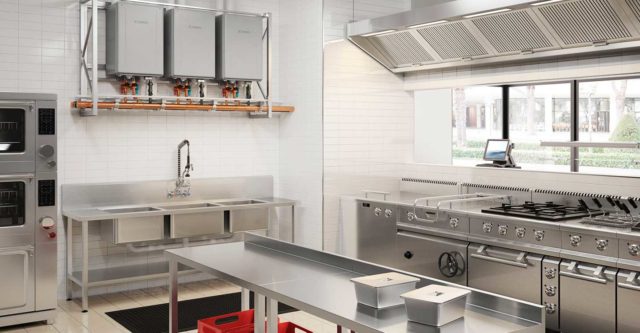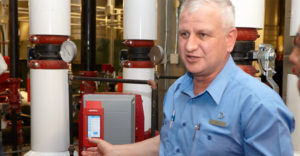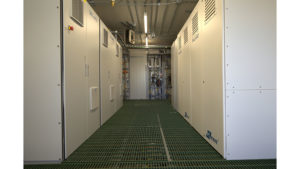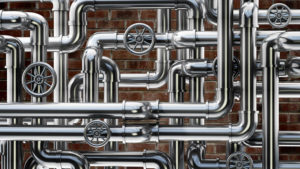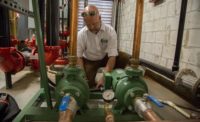Looking ahead to 2024, there could be a boost to construction associated with manufacturing, transportation infrastructure and clean energy infrastructure as funds from three key pieces of legislation passed in 2021 and 2022 — the Infrastructure Investment and Jobs Act (IIJA), the Inflation Reduction Act (IRA), and the Creating Helpful Incentives to Produce Semiconductors (CHIPS) Act — are expected to flow into the industry, according to Deloitte’s 2024 Engineering and Construction Industry Outlook. As such, construction confidence remains high, with the Associated Builders and Contractors (ABC) identifying expectations for an increase in profit margins and staffing levels, particularly in the first half of 2024.
As engineering and construction firms plan for the upcoming year, Deloitte identifies five key areas that may help them capitalize on the projected industry growth and tackle unforeseen challenges, including heightened focus on sustainability and efficiency, advancement of digitalization and generative AI, differentiated impact of market uncertainty across the residential and nonresidential segments, change in operating strategies to manage cost volatilities, demand and customer priorities, and new workforce norms to bridge the lingering talent and skills gaps.
PM Engineer sat down with several plumbing industry experts to see what engineers could expect in the coming year.
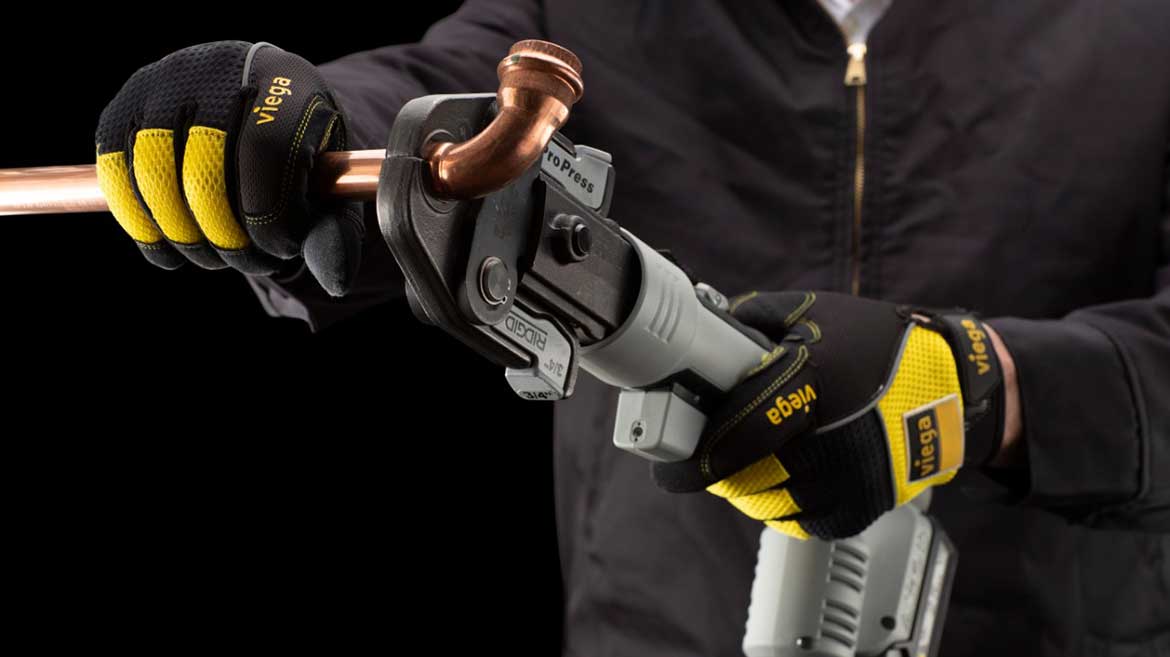
As a result of the ongoing skilled labor shortage, contractors are investing in tools and technology that make installation and completing jobs easier and more efficient, such as Viega's copper press tool.
2024 trends shaping plumbing industry
There are several trends to keep an eye on next year, according to Mark Fasel, director, PMG technical resources for the International Code Council (ICC).
“Given the unprecedented frequency and intensity of natural disasters, each occurring at a record cost of $1 billion according to the National Oceanic Atmospheric Administration, the significance of plumbing and mechanical resilience remains pivotal as we approach 2024,” he notes. “Additionally, in many regions, water reuse will become an essential strategy in water conservation, and the relationship to drain waste and venting sizes must be considered when designs incorporate low-flow plumbing fixtures. This ties into the International Code Council’s development of the ICC 815 Standard for Sizing Water Distribution, Sanitary Drainage, and Vent Piping Systems. Its development through the University of Miami, with the help of multiple international partners providing their expertise, is critical for plumbing systems to be healthy, sustainable and resilient moving forward.”
Fasel also points to the federal requirements aimed at reducing the use of high global warming potential refrigerants increasing the utilization of A2L refrigerants. “These requirements include an additional 40% decrease in the available production and consumption allowances of hydrofluorocarbon (HFCs) refrigerants through 2028. HFCs are considered climate super pollutants according to the U.S. Environmental Protection Agency. The 2024 International Mechanical Code (IMC) incorporates many new provisions addressing the use of A2L refrigerants, previously prohibited for use in many applications. For a summary of changes to the 2024 IMC on the use of A2L refrigerants visit the Code Council’s PMG Hot Topic webpage.”
Lastly, Fasel notes that $7 billion in federal funding from the Bipartisan Infrastructure Law for the development of seven U.S. Regional Clean Hydrogen Hubs, plumbing and mechanical construction opportunities will continue to grow in the industrial sector. “H2 Hub projects construction timelines are projected at 8-12 years for completion, providing for continued opportunities in future years,” he says.
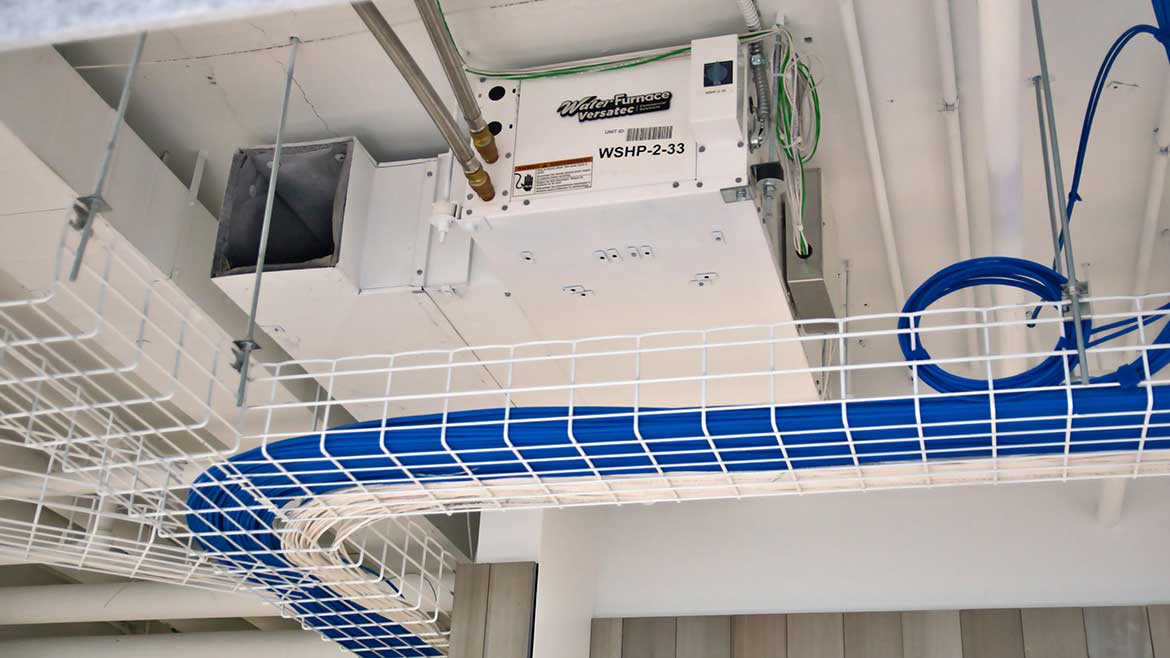
Tax credits will significantly influence both the commercial and residential geothermal marktets, notes WaterFurnace's Paul Selking.
According to Greg Eynon, senior vice president of business operations for Bradford White, one of the biggest trends manufacturers will be focused on next year is sorting out how new regulations will impact their businesses in the years ahead. “There is a tremendous amount of regulatory activity that is not yet clear, or that we are just getting clarity on. The preparation for these regulations takes years, and the impacts will be felt by the wholesaler, contractor and consumer.”
Louise Prader, senior director, product management for Bradford White, adds that on top of government and regulatory involvement, energy efficiency and connectivity will continue to shape the plumbing industry in 2024.
“The trend toward energy efficiency is driven by both consumer demand and government requirements and end users are choosing more efficient water heaters in record numbers,” she says. “Energy efficiency is not limited to heat pump water heaters (HPWHs) and tankless water heaters, as modern tank water heaters are more efficient than ever before. Heat pump technology is a long-proven technology that continues to gain momentum in the water heater industry. HPWHs are extremely efficient, and many rebates are available for choosing these products.”
Skilled labor is the single-biggest worry for the construction industry, next year and well beyond, notes Jason McKinnon, director of engineering services, Viega. “As a result, professionals are investing in ways to work through this challenge, including using more PreFab elements and technology (such as press fittings) that can allow them to complete work quickly. PreFab itself is a major trend that looks poised to only continue to grow over the next decade and more, both for plastics and metals.
“One interesting thing that we have noticed is that professionals appear to be transitioning more into plastics, specifically PEX,” he adds. “This is across all sectors and is caused by higher prices on inputs and a growing trust in plastics. As above, labor constraints are also fostering an opportunity to transition to pipe joining methods that require less training and manpower, like Viega press systems.”
Christoph Lohr, vice president of technical services and research for IAPMO and PM Engineer columnist, agrees, noting that labor shortages in installers and design professionals will be top-of-mind for the industry next year. “Finding the right qualified and credentialed professionals will be vital to fixing our 21st Century issues.”
Lohr also explains the nexus between water safety and sustainability will continue to increase in importance.
“We know public health and safety issues such as Legionella outbreaks arise when taking an overly simplistic approach to water efficiency,” Lohr says. “Research, codes and standards development, and education on this one subject will have a very big impact on plumbing engineering, installation, inspections and operations. It is the topic for the Emerging Water Technologies Conference for 2024. Sometimes these conversations are going to cause friction, and there will be a lot of debates about how to balance all the variables. Holistic thinking and industry collaboration will be important.”
≫ Back to Article Index
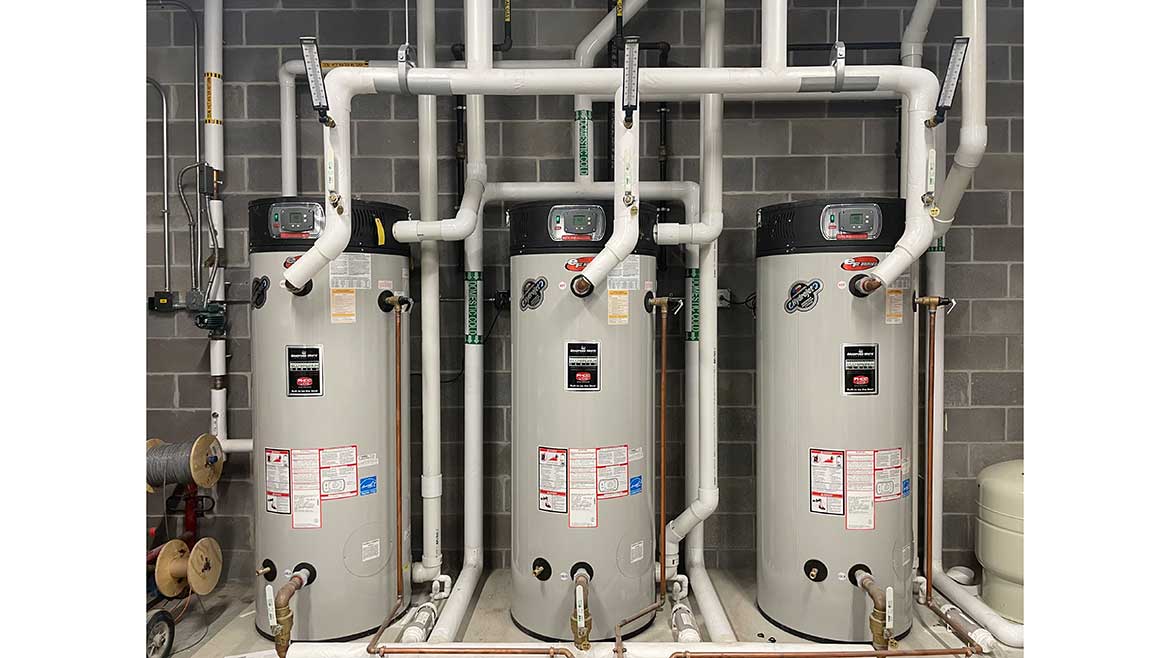
On top of government and regulatory involvement, energy efficiency and connectivity will continue to shape the plumbing industry in 2024.
Residential vs. Commercial markets
Following a 19.7% surge in spending for commercial, institutional and industrial buildings in 2023, construction industry economists expect spending growth to slow in 2024, according to the July 2023 AIA Consensus Construction Forecast Panel. Per the report, forecast panelists are calling for a modest 2% increase in overall building spending next year, with a projected modest decline in the commercial sector, a 4% increase in spending on institutional facilities and even just a 5% increase in the currently red-hot industrial sector.
“In 2024, I expect the residential plumbing sector to be flat or up slightly due to the ongoing slowdown in new construction,” says Matt Kozak, vice president of sales for Bradford White. “For the commercial sector, it may be impacted by commercial lending challenges, and predict that segment to be down. As the industry evolves and the regulatory environment changes, we will continue to offer the products and services that help our valued customers be successful in their businesses.”
According to Lohr, IAPMO’s sense is the residential sector will remain strong.
“This may take varied forms than what it has in the past, perhaps multifamily construction will continue its increase as a percent of all residential construction, especially in places like Arizona where building moratoriums due to groundwater supplies not being able to support further afield developments are now taking effect,” he notes. “The challenge on the commercial side will also be there from a plumbing standpoint, as more and more buildings will need to consider balancing water conservation and energy reduction methods with water safety. Water reuse in all forms is going to increase in importance. Whether it is rainwater capture and reuse to minimize overflow of combined sanitary/storm systems like was done in Vancouver, British Columbia to capturing water flushed by lavatories and showers in health care settings to mitigate the risk of legionella — water reuse gives the opportunity to solve what seems at the surface unrelated problems. This topic will be one to watch in 2024. The continued education of waterborne pathogens and their impact on our economy and the need to deal with contaminants such as PFAS and our drinking water are also going to be heightened. This means more expertise will be needed by the whole industry, but also there's a great opportunity to solve these big challenges.”
The demand for plumbing in commercial multifamily housing will remain strong through the first quarter, driven by several factors, including the urgent need for housing, a limited supply of pre-owned homes, the potential for rising mortgage rates to combat inflation and the willingness of young professionals to relocate in search of new opportunities, notes Fasel.
“Additionally, plumbing installations for one- and two-family dwellings will continue to remain positive and new home starts continue to soar through the end of 2023 and into 2024,” he explains. “Medical facilities have seen significant growth in 2023 and will continue to expand projects further in 2024 providing many opportunities for plumbing contracts as an aging population extends the need for additional capacity across many medical facilities. Commercial office space is expected to experience a decline compared to the levels seen in 2023 as the post-pandemic landscape has witnessed a significant shift toward remote work. And industrial development will see an increase in plumbing and mechanical construction opportunity primarily due to the growth of U.S.-based manufacturing and with the $280 billion in funding provided by the CHIPS and Science Act, growth of manufacturing facilities is projected to continue well into 2024.”
Both the residential and commercial markets will potentially be impacted by a few similar things, as well as different items in the coming year, according to Paul Selking, vice president of commercial sales and marketing, WaterFurnace.
“The similar things are clearly the two wars that are going on in the Ukraine and Israel, and also the effect of interest rates as the Fed continues to try to find that soft landing for us in the U.S. economy,” Selking says. “On the commercial side, we still see tremendous strength overall related to the Inflation Reduction Act that provides anywhere from a 30 to 50% tax payment back to the end customer. We’ll also see the overall mega trend of decarbonization and electrification being something that will continue to provide positive feedback to the commercial geothermal space in 2024.
“On the residential side, the unknown impact of the Fed's interest rates and the impact that then has on new home construction provides a little potential offset to an otherwise positive outlook again with the 30% tax credit that residential construction receives on geothermal projects,” he continues.
Additionally, tax credits will significantly influence the geothermal markets in both markets, Selking explains.
“The Inflation Reduction Act signed in Fall of 2022 has already started to positively impact the geothermal industry, and we see that continuing to progress in 2024,” he explains. “This 10-year tax incentive has some very interesting aspects to it. One is that it's on par now with solar and wind at that 30% level. It has a couple additional opportunities to increase that number to 40 or 50% of the overall cost of the project. And that overall project cost allows you to include the geothermal heat exchanger field. You know the design and engineering time put into it, and obviously the labor, the materials, and the equipment itself — so it's a very lucrative tax incentive. The other very positive impact of the tax incentive that is new starting last year is that it's also available for not-for-profit organizations — local, state and tribunal governments. In the past, the incentive was only for those corporations that had a tax liability. Now, it's available to those with and without tax liabilities as a direct payment from the Internal Revenue Service. We see that as a major change and a very positive tailwind for the geothermal space in 2024 and throughout the next 10 years.”
≫ Back to Article Index
Plumbing industry challenges
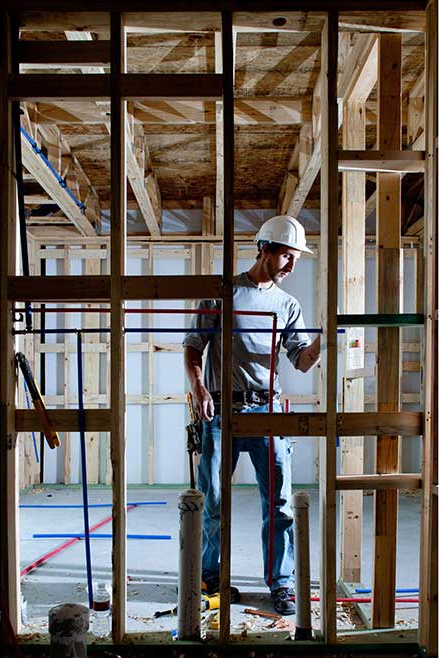
Experts anticipate the ongoing lack of tradesmen to impact both the commercial and residential sectors in 2024.
According to Jason Fleming, executive vice president and general manager at Noritz America, one of the biggest challenges over the next year is the DOE code changes that are beginning to influence plumbing engineers' design of residential and commercial water heating systems.
“Plumbing engineers will encounter more challenges to design systems for commercial water heating applications due to space and efficiency requirements while also achieving the water heating performance these applications demand,” he says. “Stand-alone commercial heat pump technologies alone will require substantial amounts of water storage and space to accommodate this type of equipment. Noritz commercial products provide space saving and efficient solutions for plumbing engineers with our commercial condensing tankless water heaters, commercial rack systems and Hybrid Hot – tankless and tank solutions.
“The other challenge the Plumbing industry is facing is the attrition of skilled labor, namely the number of plumbing professionals in the industry,” he adds. “Noritz has engineered a Total Tankless Solution (TTS Synergy Series) to provide plug and play equipment skid packages to reduce on site labor the level of expertise required to execute a commercial water heating installation.”
McKinnon points to the ever changing building and energy codes as one of the greatest challenges engineers will face in 2024.
“They require that engineers continue to evolve designs to meet rapidly changing regulations,” he says. “Another challenge is being able to readily identify which available products meet the specs and performance requirements in order to be included in a project. Viega has been poised to tackle these challenges for years. We currently provide press fittings that have passed the most standards in the industry. Not only that, we have our Engineering Services team ready to compile a complete material list and comparative data for your unique project.”
Dustin Bowerman, senior director of field services for Bradford White, believes plumbing engineers will see fewer challenges next year with product and technology mandates. “However, as product requirements from the regulatory sector come into play over the next few years, it will be imperative that engineers focus on researching future product requirements which will influence design and applications in the coming years. Bradford White’s commitment to supporting and training the professional of today and tomorrow is stronger than ever. Our For The Pro training academy, an exclusive website which offers professionals an array of tools and resources including 24/7 live staffed technical support and access to a digital learning platform, provides contractors and engineers alike, professional-grade support anytime it is needed.”
≫ Back to Article Index
Sustainability and environmental concerns influencing the industry
Decarbonization and electrification continue to be the buzzwords in the plumbing and HVAC industries heading into the next year.
In Flemming’s opinion, the push to electrification and the continuing trend on banning natural gas has the potential to be the largest market disrupter to these industries in the next year.
“Sustainability and environmental concerns will influence the plumbing industry in several ways,” he explains. “Specific to water heating, the plumbing industry will be pushed to reduce energy consumption, offset fossil fuels and reduce water waste. For example, in commercial applications, ECM technology and controls will be deployed on recirculation and system pumps to improve efficiency and reduce run time on equipment. Manufacturers such as Noritz will bring Hybrid solutions to market to offset some of the water heating gas load by combining heat pump technology and utilize condensing commercial tankless water heaters to come online when heat pump technologies are insufficient.”
Recently, California Gov. Gavin Newsom signed into law two bills that will require manufacturers, both public and private, over a certain revenue threshold to submit climate disclosures, according to Eric Truskoski, vice president of administration and government affairs for Bradford White. “This will include companies’ Scope 1, 2 and 3 emissions. While they won’t take effect in the next year, manufacturers will start to prepare for when the requirements of the legislation go into effect, some of which start in 2026 and others in 2027.
“Additionally, 25 states have now passed Fuel Choice legislation, which prohibits local governments in their states from banning the use of natural gas in new buildings,” Truskoski adds. “This is coupled with the recent United States Court of Appeals for the Ninth Circuit ruling that the City of Berkeley, California’s all-electric new building requirement, the first such policy enacted in the nation, is prohibited by federal law. Those who disagree with the court have now filed for an En Banc hearing in the Ninth Circuit in an attempt to overturn the court’s latest ruling. While there is a lot of activity that is happening around the United States related to building electrification, it remains very difficult to predict what legal and policy outcomes we’ll ultimately see, let alone how those outcomes will impact our industry moving forward.”
Sustainability and environmental concerns positively influence the adoption of geothermal technology, Selking notes.
“This is mostly driven by the decarbonization and electrification benefits geothermal enables,” he says. “It’s an environmentally-friendly option for those looking to remove fossil fuels and combustion from their building or site. This combustion often includes the exhausting of the byproduct of that combustion. With geothermal technology, nothing is burned, so safety concerns are kept at a minimum. This lack of burning also means that a byproduct is not exhausted into the air like with fossil fuels. This is becoming a more intriguing option for building owners and municipalities that are looking to make a positive impact when it comes to overall sustainability and environmental concerns.
“State and local gas bans have shined light on the need for a robust electric grid,” Selking adds. “Most of that grid issue is related to peak loading, and one of the great advantages of geothermal is it provides a great peak load shaving opportunity. The ground source used is always at a constant temperature, whether it’s 5 p.m. when everyone gets home from work and turns on their air conditioning in Phoenix or if it's in the high heating area in the middle of winter. The peak load shaving is a huge opportunity as various parts of the country continue to embrace electrification.”
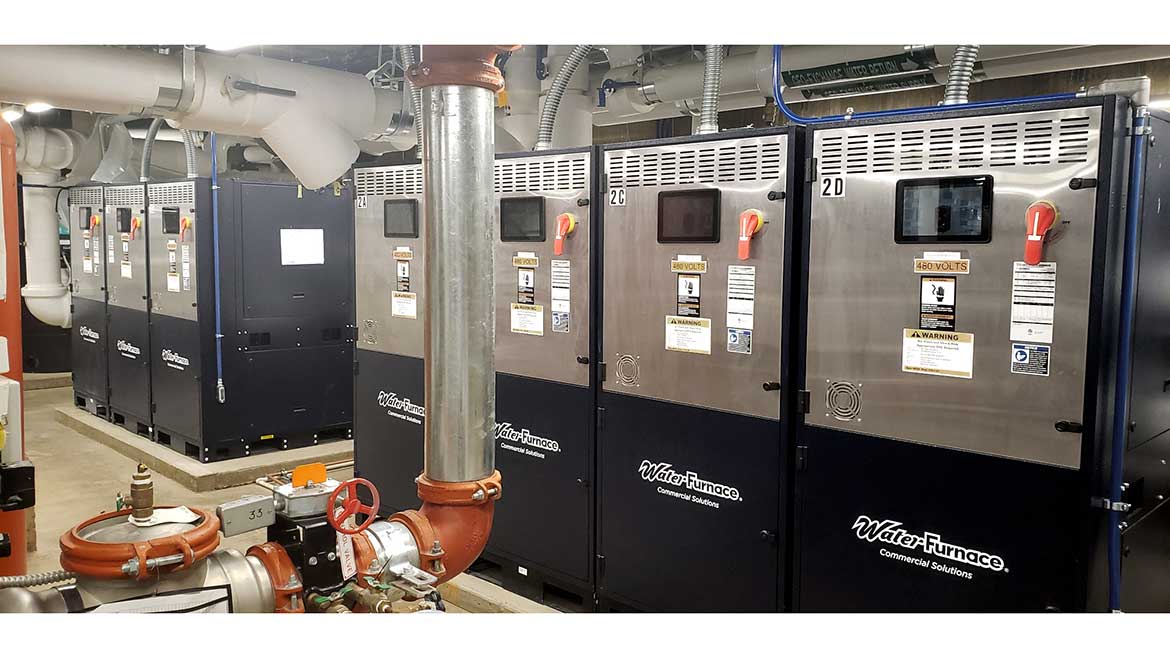
The Inflation Reduction Act signed in Fall of 2022 has already started to positively impact the geothermal industry, and Waterfurnace sees that continuing to progress in 2024,
≫ Back to Article Index
2024 Code updates
Important changes from the 2021 IPC to the 2024 IPC include:
- Provisions added for support of buried piping beneath buildings where expansive soil conditions exist;
- Requirement added for tracer wire for buried plastic sewer piping;
- Option added for vacuum testing of drain-waste-vent (DWV) piping;
- Plumbing fixture requirements significantly updated for various Group I occupancies;
- Exception added for allowing special locking mechanism for doors to multiple-user toilet facilities;
- Plastic pans for gas-fired water heaters required to be tested in accordance with ASTM E84 or UL 723;
- Showerhead flow rates have been limited to 2.0 gpm with performance complying with greater water efficiency requirements;
- Installation standards added for solvent-cemented plastic piping joints; and
- Standards added for chemical waste piping materials.
Important changes from the 2021 IMC to the 2024 IMC include:
- Requirements prohibiting the use of domestic ductless range hoods in Groups I-1 and I-2 were removed;
- Group A2L and B2L refrigerant requirements have been added in line with ASHRAE and UL Standards. Adding refrigerant piping identification requirements, machinery room requirements, and allowing the use of A2L refrigerants high probability systems used for human comfort.
- Leak detection monitoring with alarm requirements have been added where the discharge from safety relief valves is not “readily visible” to occupants;
- Outside air requirements for dwelling units have increased in line with ASHRAE 62.2; and
- Requirements for exhaust system common ducts serving separate dwelling units have been added requiring the common duct or shaft to be maintained at a negative pressure at all times.
In addition to the code updates, ICC’s International Codes have undergone substantial formatting changes as part of the digital transformation strategy of the Code Council to improve the user experience, Fasel notes. Starting with the launch of the 2024 I-Codes and beyond, the I-Codes will align print and PDF versions with ICC’s Digital Codes content. This is the biggest change in the format of the I-Codes in 25 years.
“The Code Council continues to emphasize to members and industry professionals the importance of participating in the code development process,” Fasel says. “The Code Council has also reached out to several trade associations including the UA to seek participation in the code development process by applying to serve on the Technical Committees for the 2027 I-Codes development process. In return, multiple applications for participation were received by those representing the Plumbing and Heating and Cooling trades. On Oct. 23, CDP Access opened for 2024 Group A Codes to begin code change submittals for the 2027 editions of the I-Codes. Group A Code change proposals are required to be submitted no later than Jan. 8, 2024. It is important to note that anyone can submit code change proposals and participation in the code development process is open to all.”
ICC code change submittals can be processed here: CDP Access https://www.cdpaccess.com/login/.”
For Uniform Code changes, Lohr points to IAPMO’s 2024 Guide To Important Code Changes 2024 GTICC, which was released in both electronic and print editions alongside the 2024 UPC and 2024 UMC, as a great resource for engineers and contractors.
“Typically this document was released about a year after the codes, but we worked hard to have this document and UPC and UMC Key Provisions training through IAPMO Learn available with the release of the codes,” he says.
IAPMO is currently accepting proposals for the 2027 UPC and 2027 UMC up through Jan.12, 2024.
“We have been engaging regularly with many interested stakeholders to help them through the code proposal process on our new IAPMO Codes Portal,” Lohr says. “Once all proposals are submitted, the technical committees for the UMC and UPC will meet the week of May 6-10, 2024. We would say that IAPMO already is already attracting more participation from the industry as IAPMO went to an ANSI-accredited codes development process over 20 years ago. The ANSI-accredited code process ensures that every section of industry is represented, and doing so by balancing the various interest groups (special expert, general interest, installer, manufacturer, inspector, etc.). Every interest group has a vote, which means that every interest group has a voice. The second thing we did to continue in attracting more participation from the industry is that we have offered hybrid meetings, which allows more participation from those professionals that may not be able to travel due to a wide range of reasons. We had some really deep technical discussions in the 2024 UPC and UMC process, and we're excited to continue that trend for the 2027 uniform codes.”
≫ Back to Article Index
Advice for 2024
According to Eynon, it’s critical that plumbing contracting businesses and engineering firms are immersed in the regulatory changes that will affect their business, and the businesses of their customers.
“Being informed on the latest emerging technologies and solutions will avoid headaches down the line if contractors and engineers carefully plan for future projects,” he says. “Current and pending government regulations have implications beyond 2024, especially for multi-year projects, so the products being specified and installed today could dramatically change in the years ahead.”
McKinnon advises contracting and engineering firms to partner closely with leading industry organizations to stay current on the latest code changes, new products and design trends. “Staying up to date on everything plumbing related will allow firms to stay ahead of industry trends and abreast of the latest technologies to provide the most reliable and efficient system designs.”
He also adds that firms should focus on attracting the younger generations into the plumbing industry and educating them on the vast opportunities available. “Viega is committed to educating the future generations of plumbing professionals, and currently hosts trainings, job fairs, and summer camps. Helping young people explore their professional interests, specifically in manufacturing, is essential to maintaining Viega’s high standards.”
